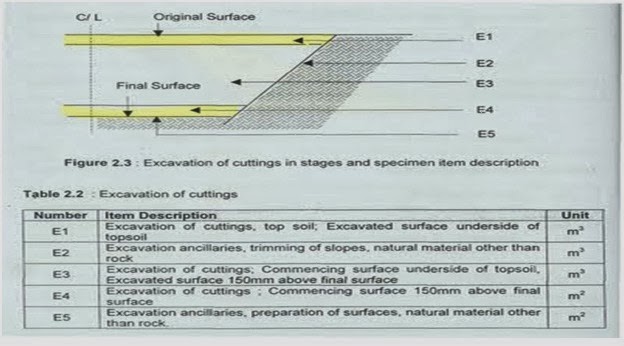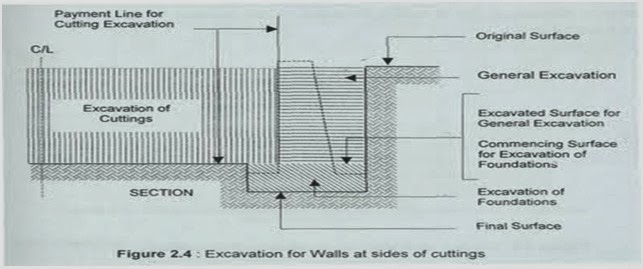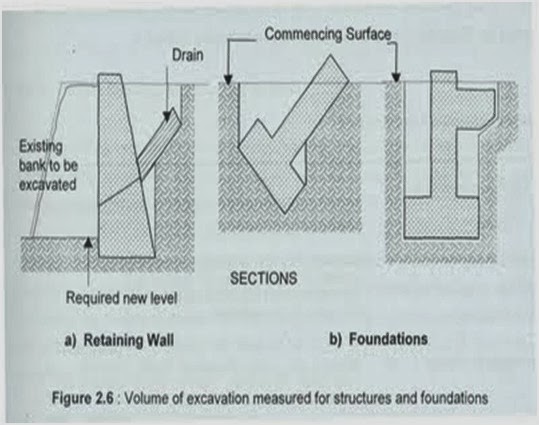|
How to measure excavation as per CESMM3
Excavation is measured by volume and the quantities are given in
the Bill of Quantities in m3. Description features for excavation and a
summary of the CESMM notes are given in Table 1. Excavation is measured the net
size of the excavated void with no allowance for working space. The volume
being that before the material is excavated.
Excavation items do not include filling and compaction. Where the operations include filling and compaction with material excavated on the site, there must be two items one for excavation and one for filling and compaction. Some cases there will be a third item of double handling where double handling of the excavated material is expressly required.
The item descriptions for excavation state what happen to the
excavated material when it is excavated whether the material is "for
re-use" or "for disposal" (meaning disposal off site or
disposal on site), the location of the disposal must be stated. If for
disposal on site there is a spreading or other deposition requirement it must
be identified in the item description. If there is a filling requirement,
such as spreading of the material to designed profiles, a filling and
compaction item in addition to the excavation item should be measured.
|
|
Unless otherwise stated all excavations are deemed to be in
natural material other than top soil or rock and all excavated materials are
deemed to be for re-use. The excavation in an item is deemed to start at the
Original Surface and finish at the Final Surface. The item descriptions
"Excavation of cuttings" or "Excavation of foundations",
"General excavation" without further wording, each denoted by
application of the provisions above. The material to be excavated is natural
material other than top soil or rock, that it is for re-use and that the
excavation in the item starts at the Original Surface and finishes at the
Final Surface. Works for which separate items are not required are noted in
the first panel of Table 2.1 (Source: CESMM).
Excavation of Cuttings
Excavation of cuttings is measured by volume and is given in m3 in the Bill of Quantities. Example of item description for the excavation of the cutting is shown in cross-section in the diagram, Figure 2.1 and Table 2.2. The item description assume : i) The excavation starts at the Original Surface and finishes at the Final Surface, ii) There is no top soil at the Original Surface, iii) All material excavated are for disposal.
The quantity attached to an item would be the volume of the material to
be excavated. The excavation of cuttings sometimes require to be measured in
stages.- It is normal for a specification to require that the bottom of
150-300mm of the excavation is left, to protect the formation, and excavated
immediately prior to the laying of the base material.
|
|
Excavation For Walls
at Sides Of Cuttings
When wall are required at the sides of cuttings, the excavation
to accommodate the wall and its backfilling is classified as general
excavation. The depth of the excavation being taken down to the formation of
the pavement abutting the face of the wall. Any excavation below the pavement
level classified as excavation of foundations. This is illustrated in Figure
2.4. Additional detail could be provided by a diagram on the drawings
indicating the measurement for measuring the excavation. The CESMM requires that
item descriptions for "Excavation of Foundations" must state the
location and limits of the excavation where is not clear.
|
General Excavation
The volume measured for the excavation of a structure or foundation is the volume occupied by or vertically above any part of the structure or foundation. The application of three situations is illustrated in the Figure 2.6.
EXCAVATION ANCILLARIES
Trimming of Slopes
|
Preparation of Surfaces
Preparation of surfaces is measured superficially in square
meters to the extent that earthworks are to receive Permanent Works other
than earthworks. The item covers merely preparing the surface to the required
profiles and configurations. It would not include any material or additional
Double Handling of Excavated Material
Double handling excavated material is measured only when double
handling is required. Consequently, excavation and filling items are deemed
to include double handling that may be necessary to carry out the earthworks.
Double handling if excavated material is measure d by volume and
is given in the Bill of Quantities in m3; The volume shall be that if the
void formed in stockpile. When calculating the volume of double handling if
excavated mate.ial for the quantities in the Bill of Quantities, an allowance
will need to be made for the difference in bulk f the material in the
stockpile and its bulk when used as filling.
When calculating the volume of material for double handling at
the site the volume of the stockpile will need to be measured both before and
after the material has been removed.
Dredging to remove silt
Dredging to remove silt is applicable only to silt which accumulated
during the maintenance period and is required to be removed. The quantities
for the Bill of Quantities will require to be estimated and measured on
completion.
|
******










